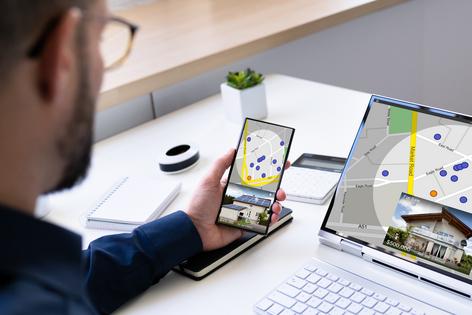The Top 8 technology and digital innovations that have transformed residential real estate since 1993
This week’s “Real Estate Matters” column is number 1,699. We started with column No. 1. In other words, we’ve been writing the column every week for almost 1,700 weeks straight. That’s just over 32 years’ worth of insights into residential real estate and answers to your questions.
Looking back, we’ve realized that real estate, like so much of the business world, has undergone a sea change in the past 32 years. We started talking about some of the seminal events that transpired in that time. It wasn’t hard to come up with a long list. It was, however, difficult to get that down to just 20 things.
We broke the list up into technology and digital transformation, lending and financial innovation, major events, and demographic and social change. This week, we’ll showcase what we believe are the Top 8 technology and digital innovations that have transformed residential real estate from 1993 through 2025. Next week, we’ll look at lending and financial innovation and major real estate events.
Here are the most significant technological innovations in residential real estate since 1993:
1. Internet-based home searches (1995-1996). Today, nearly everyone starts their search for a home online. But when we started writing this column, there wasn’t much online except AOL. In 1994, Ilyce published the first edition of her book, “100 Questions Every First-Time Home Buyer Should Ask,” and the editor wasn’t sure if she should put her new AOL email address in print. Early real estate websites, like Realtor.com, launched in 1995 and 1996 and began to change how buyers searched for homes. But the invention of Google really took search into a fundamentally different stratosphere. As a by-product, it killed off newspapers and changed media forever.
2. Automated Valuation Models (AVMs) (1990s-2000s). How much is your property worth? It used to be that only an appraiser could value property. But in the late 1990s, they became much more popular, as statistical models developed and large property databases were built. CoreLogic, a real estate data company, and Freddie Mac, a secondary mortgage market leader, were early adopters. But AVMs really took off when Zillow created its “Zestimate” tool.
3. Multiple Listing Service (MLS) digitization (late 1990s). As late as the 1980s, if you wanted to learn about a house that was for sale, you needed to go to a real estate agent’s office to see the MLS book. Literally, it was the size of a phone book. Each listing was tiny, with a short description and one grainy black and white photo of the front of the house. If you wanted more information, the agent had to pull it from the MLS. But in the late 1990s, MLS systems started to transition from paper-based to digital listing systems. In the early days, you could still upload only one photo. Today, you can put up any number of high-resolution photos, videos, blueprints, layouts, and almost anything else you can think of. The big question, however, is who owns all that data?
4. Zillow’s launch and Zestimate (2006). Zillow and Trulia, which Zillow bought in 2015, have changed the way buyers, sellers and renters think about property. Zillow introduced automated home valuations to consumers, democratizing property value estimates. With the current battle against Compass, it’s still fighting the battle to get as much information as possible into consumers’ hands. Today, Zillow generates almost 263 million visits per month. Trulia gets more than 20 million visitors per month. Let’s put that into context: Fewer than 6 million existing and new construction homes are expected to sell this year.
5. Digital mortgage applications (2000s-2010s). Online mortgage processing became standard in the early 2000s. Prior to the advent of digital mortgage applications, the only way to apply for a loan was in person.
6. Virtual tours and 3D home viewing (2010s). Matterport and similar technologies revolutionized property marketing. During these years, real estate agents began using drones to market properties along. These videos, along with Google Street View and Bing maps, gave homebuyers the opportunity to view properties and the surrounding areas without leaving their computers.
7. iBuying emergence (2014-2018). As the United States began to emerge from the Housing Crisis and Great Recession of 2008-2009, companies like Opendoor and Offerpad created instant-offer homebuying models. There were several interesting ideas behind this: Could you hire real estate agents and pay them a salary and benefits? Would sellers accept less money in exchange for being able to unload property? Could you make this a seamless transaction for everyone?
The models worked until they didn’t, and some of these companies imploded. Opendoor Technologies (NASDAQ: OPEN) is still around, bills itself as a leading e-commerce platform for residential real estate transactions, and reported $1.4 billion in revenue for Q4 2024.
8. PropTech explosion (2010s-2020s). As we entered the second decade of the century, AI-powered pricing, digital closings, and automated property management became popular ideas. As the housing crisis slowly recovered, improving cloud technology gave investors, developers, and other real estate stakeholders an opportunity to invest in technology that improved different parts of the real estate world. Being able to do virtual closings, which became extremely popular during the COVID-19 pandemic, allowed buyers and sellers to do business even when the world was mostly shut down. And, there’s no going back.
========
(Ilyce Glink is the author of “100 Questions Every First-Time Home Buyer Should Ask” (4th Edition). She is also the CEO of Best Money Moves, a financial wellness technology company. Samuel J. Tamkin is a Chicago-based real estate attorney. Contact Ilyce and Sam through her website, ThinkGlink.com.)
©2025 Ilyce R. Glink and Samuel J. Tamkin. Distributed by Tribune Content Agency, LLC.

































Comments